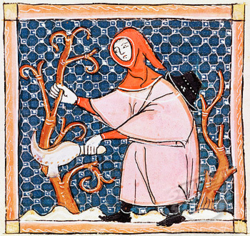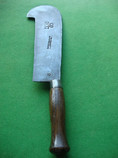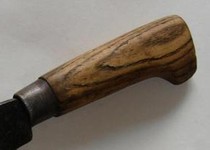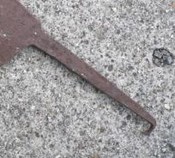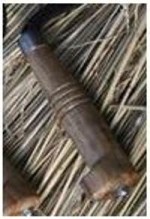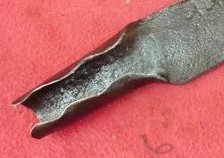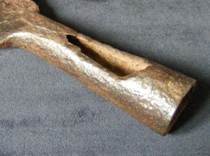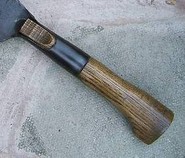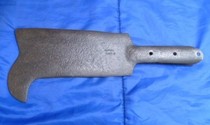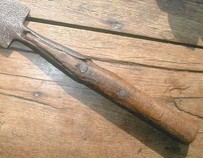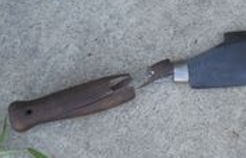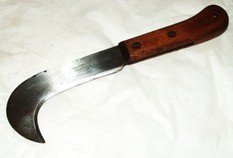Handles
In the UK the most common methods of fixing the handle to the blade are by using a tang that passes through the handle, or a socket that encloses it, although on the Yorkshire billhook the handle is commonly fixed like that of a slasher with two straps, one each side of the handle, fastened by three rivets.
Like any tool, a billhook consists of a working part (the blade) and a handle which allows the user to pick it up, use it and control its movement. The shape, length, material used and method of fixing it to the blade can allow one to identify the country of origin, or even the region within a country.
The most commonly used material is wood, but leather, horn, bone and even ivory have been used. Some blades are forged with an integral handle, usually in the form of a hollow socket, but not intended to receive a wooden insert.
In the UK the most common wood is ash (the traditional wood for all tool handles) but hickory handles are becoming more common (in the USA it is the wood of choice for tool handles). The use of both ash and hickory is probably a way of using all the small offcuts left when producing larger handles, e.g. garden tools, axes, sledgehammers or pickaxes. As the handle is not highly stressed other woods have been used, e.g. willow, hazel or beech and in France red beech and cormier (wild service tree) are common.
The most common handle types are the 'caulked' handle with an extension to prevent it slipping out of the user's hand, and a round handle that is most commonly used on double edged billhooks as it can be used in any position
On the billhooks of Belgium and Holland the end of the tang is often threaded and a nut and washer used to fix the handle. This example is from a thatcher's shearing hook made by Simon Grant-Jones in Dorset who also uses the same method on his billhooks.
Often seen on imported tools that originate from India and Pakistan, some billhooks have a short tang that does not pass through the handle. The handle is fastened by a transverse rivet through the ferrule. This a bad method that weakens both the tang and the handle. DO NOT buy a billhook with a handle like this...
The 'scale' tang is not common on English billhooks, but can be found on similar tool such as leatherworkers' knives, or lino knives. This example by Martindale is a tea knife, made for export to India. The handle is one piece of hard wood partially sawn to take the tang, but often two separate scales are seen, rivetted through the tang.
